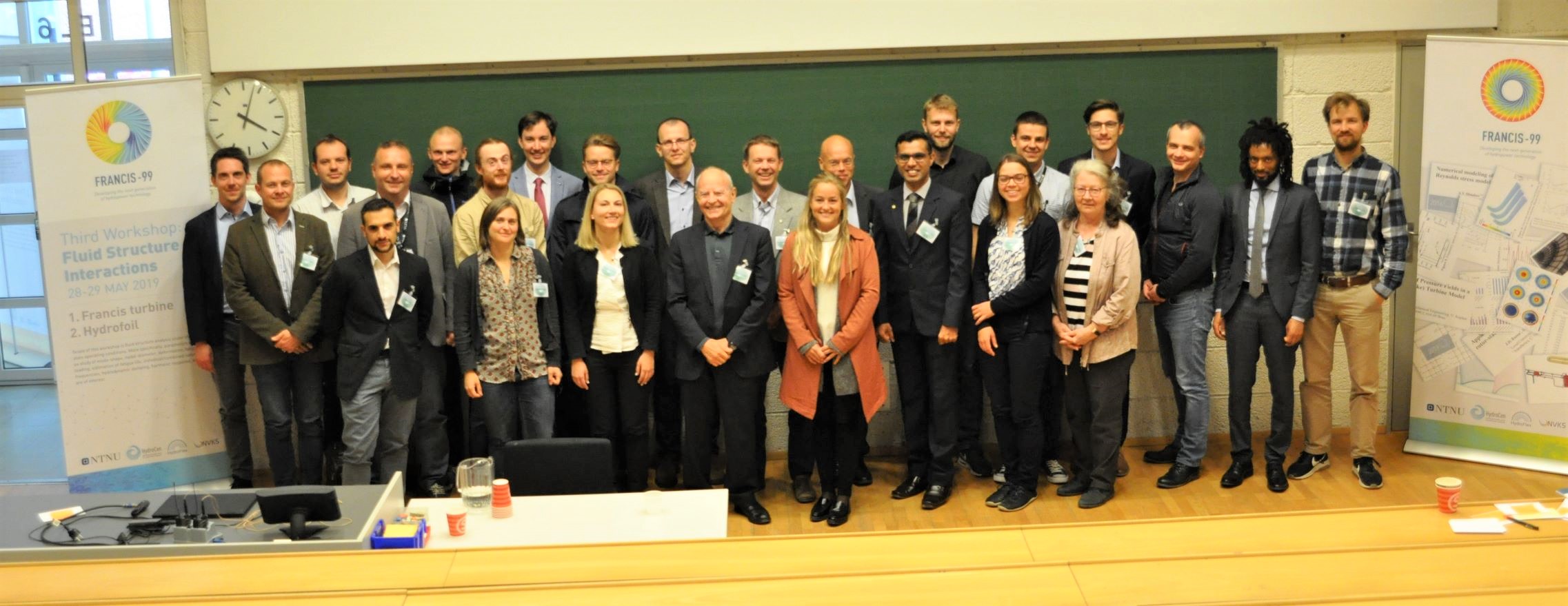Francis-99
Francis-99
Francis-99
Francis-99 is a series of workshops, which provides an open access of data related to different test cases including Francis turbine and hydrofoils. The researchers can use these data and perform numerical studies by applying modern tools and techniques.
Flexible electricity demand and low profit margin have pushed hydro turbines to their extreme operating limit. The turbines are often operated at unfavourable load, which has raised significant concerns for the hydropower industry and has challenged the existing design criteria. In fact, the main requirement for modern turbines is high efficiency over the whole operating range. However, this is difficult to obtain.
Computational fluid dynamic (CFD) techniques have been extensively used in turbine design. There are significant challenges in the numerical modelling due to complex flow structure in the turbine. A particular technique applied to an operating load does not work for another operating load of the same turbine. This results in a time consuming process, which makes the numerical modeling of the hydraulic turbine expensive in terms of the requirement of computational power and time. In a competitive market higher cost is not affordable. Therefore, there is a need to optimize the CFD modelling applied to investigate the hydro turbines.
Moreover, due to confidentiality, none of the modern turbine designs are available in public domain. This makes it difficult for engineers/researchers to explore their skill and knowledge in evaluating hydro turbine designs. The academicians do not have access to the modern design techniques adopted by the industries except through collaborating work.
Main objective of Francis-99
Francis-99 is a series of workshops, which provides an open access of data related selected test cases including Francis turbine and hydrofoils. The open data includes CAD model/geometry, mesh for simulations and the experimental data (pressure and/or velocity). It provides an open platform to the hydropower researchers and possibility to explore their capabilities and enhance their skills. In fact, this is the main objective of the workshop series. The researchers can use these data and perform numerical studies by applying modern tools and techniques.
So far three workshops have been completed successfully. The first workshop aimed at steady state operating conditions of Francis turbine, investigating the pressure pulsations and vortex breakdown. The second workshop aimed at transient operating conditions such as load variation and start-stop. The third workshop aimed at fluid structure interactions. For more information, please visit the webpage for each workshop.
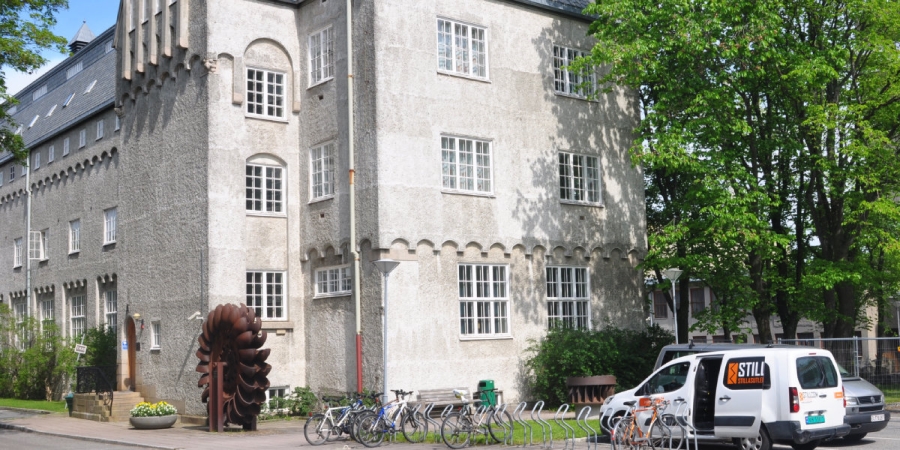
Photo: Chirag Trivedi, 02 July 2015.
The Waterpower laboratory is actively involved in research and development of hydro turbines since 1917. It consists of a flexible infrastructure, which gives the possibility to operate test rigs in open and close loop configurations. There are two turbine test rigs, Francis turbine/pump-turbine and Pelton turbine, and several piping loops for the investigations of water hammer, surging, pressure-time method, etc. Laboratory personnel conduct field measurements such as efficiency measurement, pressure pulsations, vibration, etc. The turbine testing is conducted according to IEC 60193 and IEC 60041.
The close loop piping system in the Waterpower laboratory can be pressurised to maximum of 100 m and the open loop system has a maximum head of 16 m. Available pumping power is 700 kW and the maximum flow rate is 1.1 m3 s-1. Achieved maximum hydraulic efficiency of the model Francis turbine is 93.4%. Pressure and velocity measurements are frequently conducted in the laboratory. An average of one PhD thesis, ten master thesis, and ten student projects are conducted per year. The laboratory is actively involved in research and development projects through industrial and academic collaborations, and it always encourages young researchers and welcomes to conduct research. Ongoing PhD level research work in the laboratory can be found here.
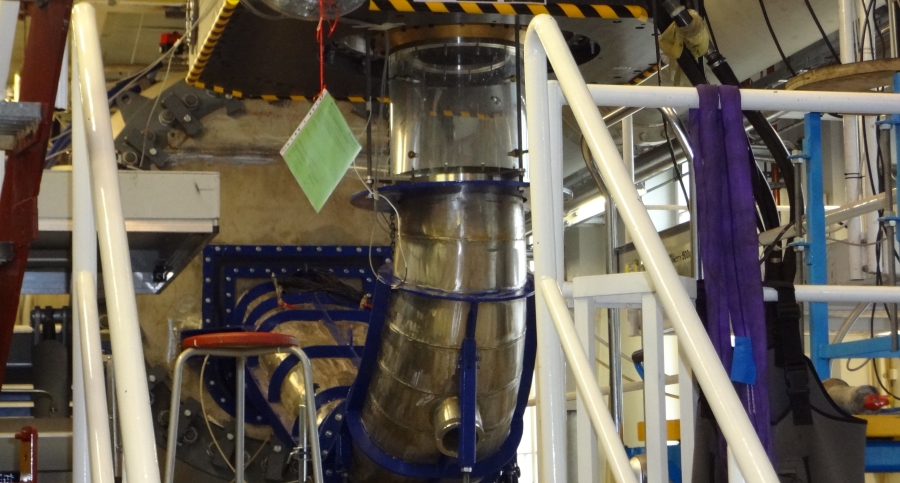
Photo: Chirag Trivedi 29 May 2012.
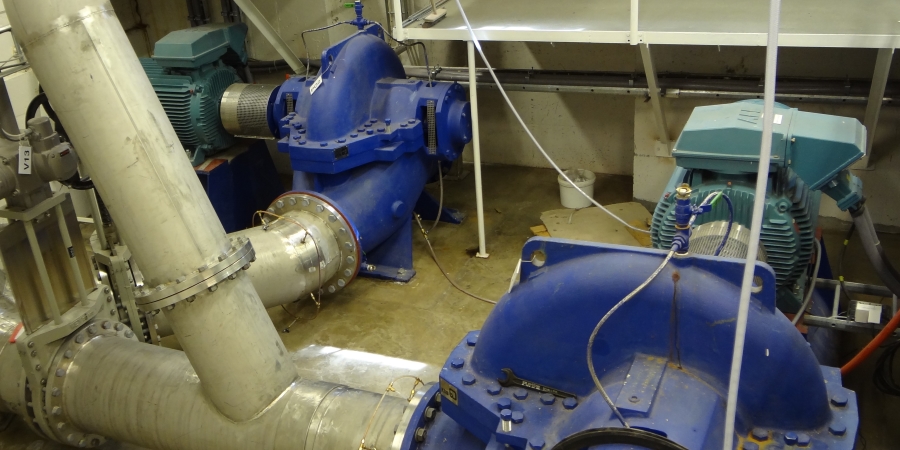
Photo: Chirag Trivedi 29 May 2012.
The model Francis turbine utilized for Francis-99 is a scaled model of the turbines operating at Tokke power plant in Norway. The Francis turbine has a splitter blade runner, which includes 30 blades. The runner outlet diameter is 0.349 m. The obtained maximum hydraulic efficiency of the turbine is 93.4% at the best efficiency point and the uncertainty was +/- 0.16% [1]. The test rig is extensively used for the model testing and for specific investigations such as rotor stator interaction, vortex rope, rotating stall with pump-turbine runner, water hammer, cavitation, etc. The open loop hydraulic system is used to perform transient measurements such as load variation, start-stop, and total load rejection. Moreover, strict guidelines are used for the calibration of each instrument utilized during the measurements. Complete history of the calibrated instruments is maintained for reference study in order to observed any deviation of the characteristics over time.
[1] Chirag Trivedi, 2014, Experimental and numerical investigations on steady state and transient characteristics of a high head model Francis turbine, Ph. D. thesis, Indian Institute of Technology Roorkee.
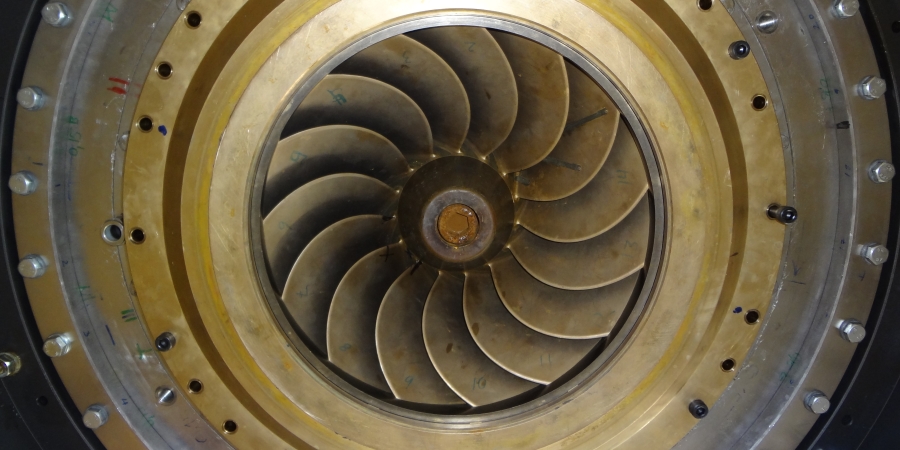
Photo: Chirag Trivedi 29 May 2012.
The model Francis turbine runner is scaled 1:5.1 to the prototypes operating at Tokke power plant. The leading edge profiles of the runner main blades and splitter blades are similar. The main blades are twisted around 180 degree from inlet to the outlet of the runner. The blade thickness at the trailing edge is 3 mm. Runner inlet and outlet diameters are 0.63 m and 0.349 m, respectively. The runner inlet height is 0.06 m and the specific speed is 0.27. Miniature pressure sensors are integrated in the runner to acquire pressure values during the measurements. Wireless telemetry system is used to transmit the pressure values from the runner to the stationary logging system. In Norway, the majority of the turbines are ranged from mid-head to high-head. This model turbine has played important role in the research and development of the high head turbines over the last decade.
Highlight of the first workshop
The first workshop was held 15th and 16th of December 2014 at the Norwegian University of Science and Technology. Various researchers have conducted extensive numerical studies on the high-head Francis turbine, and the obtained results were presented during the workshop. Approximately 50 researchers participated in the workshop, and 14 papers were presented. Almost all aspects of numerical studies were discussed during the workshop including numerical modelling, meshing, verification and validation, challenges in the numerical study, and how can numerical modelling be optimized.
See the detailed summary of the Francis-99 first workshop.
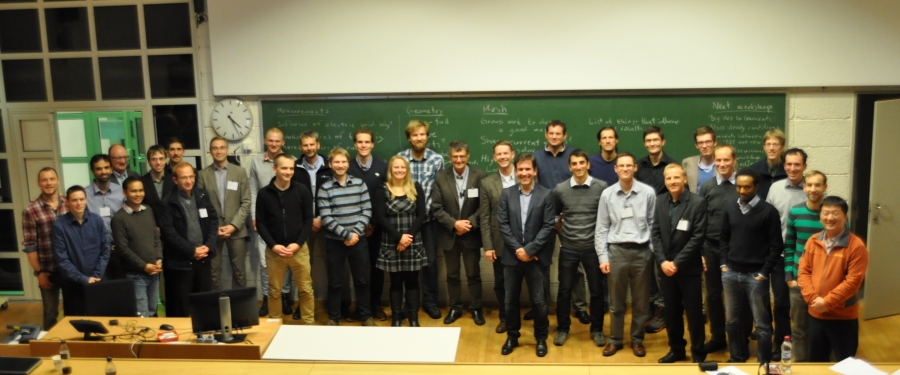
Photo: Chirag Trivedi 16 December 2014.
Highlight of the second workshop
The second Francis-99 workshop was organized on 14 and 15 December 2016. Total 10 research papers were presented in the workshop. Around 35 researchers from different countries were participated in the workshop. Both steady and transient simulations were presented and discussed during the workshop. For the transient simulation, mesh deformation approach was used. Key concern was long simulation time during load variation and start-stop. There was alternative suggestion to use 1D-3D coupling that allow reduction of time. Main components of the turbines can be modelled using 3D and data from 1D analysis should be used as boundary condition. Further, size of the 3D CFD domain can be reduced by using passage modelling approaches as highlighted in the first workshop. Results presented from the hydropower industries indicated that modern passage-modelling techniques should be used which allow rough estimation of pressure loading on the blades during load variation and start-stop. Results presented using different techniques/solvers such as Ansys, star-ccm+, OpenFOAM have shown that newly implemented techniques can help to overcome the challenges in transient modelling and can provide results with improved accuracy.
See the detailed summary of the Francis-99 second workshop.
Highlight of the third workshop
The third workshop was organized during May 28-29, 2019, which focused on fluid structure interactions in Francis turbine. However, in this workshop, two test cases were provided: (1) Hydrofoil and (2) Francis turbine. The hydrofoil test case aimed to investigate fundamental research, and the turbine test case aimed to investigate applied research. Parameters such as study of mode-shape, nodal-diameter, deformation, fatigue loading, estimation of fatigue life, individual/combined natural frequencies, hydrodynamic damping, harmonic response, etc. were investigated. In total 11 papers were submitted to the workshop and around 35 participants from different countries, Canada, Spain, Germany, Croatia, Sweden, North Macedonia, Norway, etc., joined the workshop.
See the detailed summary of the Francis-99 third workshop.
